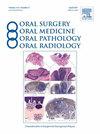Curing through Ceramics: Influence of Different Light-Curing Units and Curing Modes on Bond Strength
Oral surgery, oral medicine, oral pathology, oral radiology, and endodontics
Pub Date : 2022-02-17
DOI:10.3390/oral2010008
引用次数: 1
Abstract
Objectives: To measure and compare the bond strength between three different types of ceramics and resin cement, as well as the degree of conversion of resin cement after using different light-curing units and curing modes. Methods: Three types of ceramics—Leucite-reinforced (Empress CAD), Lithium disilicate (Emax CAD), and Zirconia (Emax ZirCAD)—of varying thicknesses (1.5 mm and 2.0 mm) were bonded to a light-cure resin cement (Variolink Esthetic LC). Light-curing was carried out using a monowave LCU (3M Elipar DeepCure-S LED Curing Light with irradiance of 1470 mW/cm2) and with polywave LCU (Ivoclar Bluephase PowerCure) using High, Turbo, and 3 s curing modes, respectively (1200, 2100, 3000 mW/cm2). A chevron-notch bond strength test (total n = 288) was conducted to calculate the fracture energy and interfacial bond strength (J/m2). The degree of cure (%DC) of the residual resin cement on debonded surfaces was measured using Fourier Transform Infrared Spectroscopy (FTIR). Collected data were statistically analysed under SPSS ver. 27 by conducting an ANOVA and Bonferroni post hoc test. The mode of failure was established using a scanning electron microscope (SEM). Results: A significant difference in interfacial bond strength was found between the three types of ceramic material groups (p < 0.01). Cement cured through Empress that was 2 mm thick showed the highest bond strength (1.36 ± 0.46 J/m2), while the lowest was observed (0.26 ± 0.07 J/m2) in 2 mm Emax CAD using the 3 s mode. The use of different LCUs and curing modes had a significant influence on the %DC of resin cement seen in all groups, except 2 mm Emax ZirCAD. The dominant mode of failure for Empress, EmaxCAD, and EmaxZirCAD were cohesive, adhesive, and mixed, respectively. Conclusions: The type of ceramic and its thickness can significantly affect bond strength, and the results showed that polywave LCU is more effective than monowave LCU when curing through ceramics.陶瓷固化:不同光固化单元和固化方式对结合强度的影响
目的:测量和比较三种不同类型陶瓷与树脂水泥的粘结强度,以及树脂水泥在采用不同光固化单元和固化方式后的转化程度。方法:将三种不同厚度(1.5 mm和2.0 mm)的陶瓷-白石增强(Empress CAD),二硅酸锂(Emax CAD)和氧化锆(Emax ZirCAD)粘合在光固化树脂水泥(Variolink aesthetic LC)上。光固化采用单波LCU (3M Elipar DeepCure-S LED固化灯,辐照度为1470 mW/cm2)和多波LCU (Ivoclar Bluephase PowerCure),分别采用高、Turbo和3s固化模式(1200、2100、3000 mW/cm2)进行。采用字形缺口结合强度试验(总n = 288)计算断裂能和界面结合强度(J/m2)。利用傅里叶变换红外光谱(FTIR)测量了树脂水泥在脱粘表面的固化度(%DC)。收集的数据在SPSS软件中进行统计分析。通过方差分析和Bonferroni事后检验。利用扫描电子显微镜(SEM)建立了失效模式。结果:三种陶瓷材料组间界面结合强度差异有统计学意义(p < 0.01)。2 mm厚的Empress固化水泥粘结强度最高(1.36±0.46 J/m2), 3 s模式下2 mm Emax CAD固化水泥粘结强度最低(0.26±0.07 J/m2)。除2 mm Emax ZirCAD外,不同lcu的使用和养护方式对树脂水泥的%DC均有显著影响。皇后、EmaxCAD和EmaxZirCAD的主要失效模式分别为内聚、粘接和混合。结论:陶瓷的种类和厚度对粘结强度有显著影响,结果表明,在陶瓷固化过程中,多波LCU比单波LCU更有效。
本文章由计算机程序翻译,如有差异,请以英文原文为准。
求助全文
约1分钟内获得全文
求助全文
来源期刊
自引率
0.00%
发文量
0
审稿时长
1 months

 求助内容:
求助内容: 应助结果提醒方式:
应助结果提醒方式:


